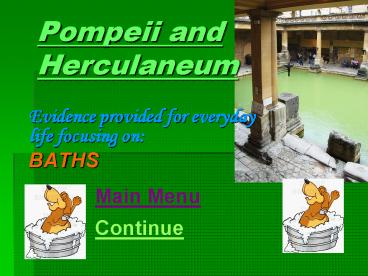Evidence provided for everyday life focusing on: PowerPoint PPT Presentation
1 / 18
Title: Evidence provided for everyday life focusing on:
1
Pompeii and Herculaneum
- Evidence provided for everyday life focusing on
- BATHS
Main Menu
Continue
2
LINKS
Everyday life Baths
- Use of baths
- Style of baths
- Significance of baths
3
Use Of baths
What were the baths used for?
- The baths at both Pompeii and Herculaneum were
gathering spots open to the public and for the
rich to socialize . - There are four different parts to a complete
bath, each having a specific purpose.
Apodyterium
Frigidarium
Caldarium
Hypocausts
4
Apodyterium
- The apartment at the entrance of the baths, or in
the palestra, where one stripped a dressing
room. - Women's Apodyterium
- Generally had lockers in in this room but were
would be marked with sexual symbols because most
of the population would be illiterate
5
(No Transcript)
6
frigidarium
This was coldest room in the regular sequence of
bathing rooms. Architecturally, the room varied
in design and dimensions. The earliest forms are
represented in the small, isolated rotundas given
over entirely to cold plunge pools found in the
baths of Pompeii and Herculaneum.
The frigidarium, a circular pool that once
contained frigid water.
7
Hypocausts
It would of taken till around midday until the
furnaces would be fully stoked with hot air
circulating around underneath the marble.
8
Caldarium
This was hottest room in regular sequence of
bathing rooms. It is described in detail by
Vitruvius and mentioned by Pliny who terms it a
cella caldaria. Sidonius Apollinaris uses the
term cella coctilium, the "room of the dry wood
(for burning)."
It's form and function have been fully studied by
modern scholars such as Nielsen and Yegul.
9
Reasons why they look like that
Style of baths
The baths at both Pompeii and Herculaneum were
designed for a specific purpose. Every bit of
construction had a purpose for the overall
picture.
10
(No Transcript)
11
The room had only one opening and one source of
natural light. The opening was situated on the
dome of the roof as it would let in natural light
and because the Frigidarium was a cool room, when
it rained natural water could fall and cool down
individuals. Because people were having baths,
generally they would want privacy and that is why
there is only one window like feature. Because it
was situated upon the roof people couldnt pry
into the activities of bathers.
The baths was a cool room in which people could
socialise and cool down. There are social aspects
to the the circular design as it would include
all people to the conversation therefore making
people equals.
12
Gradually the room evolved into to the colossal
cross-vaulted central chambers of the imperial
thermae. The modern visitor, entering the
basilica on a hot summer's day, can immediately
feel the effect of the high roofs and windows,
developed to have that exact cooling effect have
had high roofs exactly for this effect.
Occasionally, changing rooms doubled as
frigidarium, when cold pools were provided in
them. The grooves on the roof was made to keep
condensation from dripping on bathers.
13
Many different types of frescos and mosaics are
situated around all types of baths. This could be
a form of education or advertising as suggested
by the following fresco.
14
Significance of baths
What was it used for?
- There were many different reasons in which people
went to baths. Most people would go for
cleanliness or for a social event. - Nearly everyone went to baths generally in the
afternoons. - The only people who didnt go to public baths
were slaves and the very poor. - Most rich house had a bath of some sort in their
own house.
15
Services
These pictures were found in a changing room at
one side of the newly excavated Suburban Baths in
the early 1990s. People are not quiet sure what
they represent entirely.
The public bath was largely abandoned in the
Middle Ages, except for the communal "stew" for
feasting and prostitution.
They know its of a sexual nature and some believe
it to be of some kind of advertise that promoted
prostitutes on the second level.
Or it could be symbols to peoples lockers as
before mentioned.
16
Gathering placefor socials
These are casts from the bodies found after the
eruption of Vesuvious. Like these bodies, many
skeletal remains exists to indicate that the
baths were social gathering places in which
people would meet to catch up or enjoy the
company of someone else or find someone to talk
to.
17
Fitness and exercise
The baths at both Pompeii and Herculaneum were
acomidating not only for lesire activites but
also for people wanting to work out.
The main building contained not only ample
accommodation for bathing and swimming, but,
halls suitable for gymnastic exercises.
as well as two palaestras, gyms where wrestling
and boxing was practiced, The north end of the
complex contained a natatio or swimming pool.
18
Leisure activities
The main building contained not only ample
accommodation for bathing and swimming, but
salons for the conversation of lounging
patricians, halls suitable for gymnastic
exercises, and rotundas where philosophers might
argue and poets declaim.
The libraries were located in exedrae on the east
and west sides of the bath complex. The entire
north wall of the complex was devoted to shops.
The reservoirs on the south wall of the complex
were fed with water from the Marcian Aqueduct.

